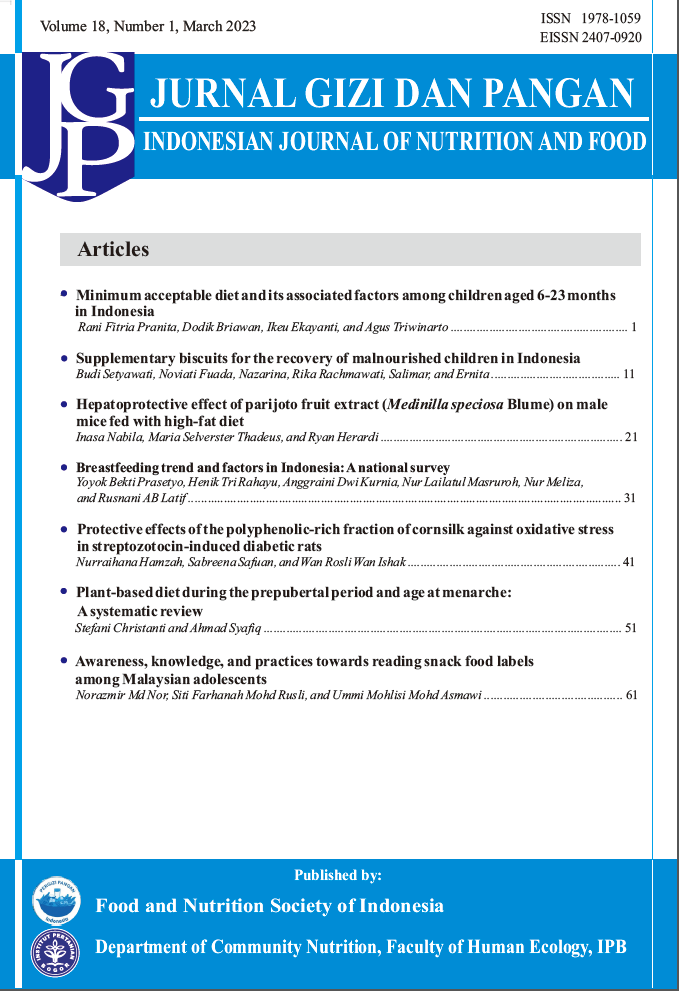Awareness, Knowledge, and Practices towards Reading Snack Food Labels among Malaysian Adolescents
Abstract
This study aimed to determine the awareness, knowledge, and practices regarding food labels and factors that influence their use; a cross-sectional study was conducted among 200 Malaysian adolescents aged 10 to 19. Participants completed an online Food Label Use Questionnaire (FLUQ) that included demographic, nutrition knowledge, label use, and factors affecting label use. SPSS version 28.0 was used for data analysis. The results showed that 93% of adolescents correctly identified the consequences of over-consuming calories. Still, only 84.5% performed well on the nutrition use task, struggling to interpret calorie and carbohydrate amounts in certain foods. The main reasons for not using food labels were time constraints (45.5%), unattractive or confusing labels (36%), absence of labels on certain foods (33%), lack of health concerns (32%), and insufficient knowledge (27%). However, 90.5% of adolescents were concerned about product expiration dates and often read this information. Taste and price were the main reasons for referring to food labels, while time constraints were the main barrier to their use. In conclusion, practicing reading food labels can guide adolescents in making informed decisions about their food choices and portion intake. Awareness campaigns can aid in promoting healthy habits and empowering adolescents to make the right choices for their health.
References
Evelyn H, Aziz AF, Sariman S. 2020. Associations of knowledge, attitude and practices of food label on cardiovascular diseases (CVD) risk amongst university students in Selangor, Malaysia. J Nutr Sci Vitaminol 66(Supplement):S275‒S282. https://doi.org/10.3177/jnsv.66.S275
Jefrydin N, Nor NM, Talib RA. 2019. Nutrition labelling: An exploratory study on personal factors that influence the practice of reading nutrition labels among adolescents. Malays J Nutr 25(1):143‒153. https://doi.org/10.31246/mjn-2018-0123
Jovicic N, Smith K, Guo X, Wang Y. 2021. The effectiveness of nutrition label interventions on improving dietary intake and nutrition-related health outcomes: A systematic review. Appetite 167:105615.
Jung T, Huang J, Eagan L, Oldenburg D. 2019. Influence of school-based nutrition education program on healthy eating literacy and healthy food choice among primary school children. Int J Health Promot Educ 57(2):67‒81. https://doi.org/10.1080/14635240.2018.1552177
Kansal S, Raj A, Pedapanga N, Worsley A, Rathi N. 2023. Indian adolescents' perceptions of packaged food and food labels-A qualitative inquiry. Appetite 180:106342. https://doi.org/10.1016/j.appet.2022.106342
Kattelmann KK, White AA, Greene GW, Byrd-Bredbenner C, Hoerr SL, Horacek TM, Kidd T, Colby S, Phillips BW, Koenings MM, Brown ON. 2014. Development of young adults eating and active for health (YEAH) internet-based intervention via a community-based participatory research model. J Nutr Educ Behav 46(2):S10‒S25. https://doi.org/10.1016/j.jneb.2013.11.006
Krejcie RV, Morgan DW. 1970. Determining sample size for research activities. Educ Psychol Meas 30(3):607‒610. https://doi.org/10.1177/001316447003000308
Miller LMS, Cassady DL. 2015. The effects of nutrition knowledge on food label use. A review of the literature. Appetite 92:207‒216. https://doi.org/10.1016/j.appet.2015.05.029
Norazmir MN, Norazlanshah H, Naqieyah N, Anuar MK. 2012. Understanding and use of food package nutrition label among educated young adults. Pak J Nutr 11(10):836‒842. https://doi.org/10.3923/pjn.2012.934.940
Nurliyana G, Norazmir MN, Anuar MK. 2011. Knowledge, attitude and practices of university students regarding the use of nutritional information and food labels. Asian J Clin Nutr 3(3): 79‒91. https://doi.org/10.3923/ajcn.2011.79.91
Rezali FW, Chin YS, Yusof BNM. 2012. Obesity-related behaviors of Malaysian adolescents: A sample from Kajang district of Selangor state. Nutr Res Pract 6(5):458‒465. https://doi.org/10.4162/nrp.2012.6.5.458
Saha S, Vemula SR, Mendu VVR, Gavaravarapu SM. 2013. Knowledge and practices of using food label information among adolescents attending schools in Kolkata, India. J Nutr Educ Behav 45(6):773‒779.https://doi.org/10.1016/j.jneb.2013.07.011
Shah M, Adams-Huet B, Elston E, Hubbard S, Carson K. 2010. Food serving size knowledge in African American women and the relationship with body mass index. J Nutr Educ Behav 42(2):99‒105.https://doi.org/10.1016/j.jneb.2009.02.001
Shen M, Shi L, Gao Z. 2018. Beyond the food label itself: How does color affect attention to information on food labels and preference for food attributes? Food Qual Prefer 64:47‒55. https://doi.org/10.1016/j.foodqual.2017.10.004
Shireen S, Muthumareeswari S, Sumaya BK, Lakshmi Shree R. 2022. Food label and its influence among Indian consumers-a review. Journal of Food Science and Nutrition Research 5(2):543‒551.
Talagala IA, Arambepola C. 2016. Use of food labels by adolescents to make healthier choices on snacks: A cross-sectional study from Sri Lanka. BMC Public Health 16(1):1‒11. https://doi.org/10.1186/s12889-016-3422-1
Tan AK, Yen ST, Fang X, Chiang FS. 2019. Body weight and physical activity of adolescents in Malaysia. International Health 11(2):150‒158.https://doi.org/10.1093/inthealth/ihy072
Uwimana-Nicol J, Hendricks L, Young T. 2021. Population-level interventions targeting risk factors of diabetes and hypertension in South Africa: A document review. BMC Public Health 21:1‒14. https://doi.org/10.1186/s12889-021-11910-6
Authors

This work is licensed under a Creative Commons Attribution-ShareAlike 4.0 International License.






